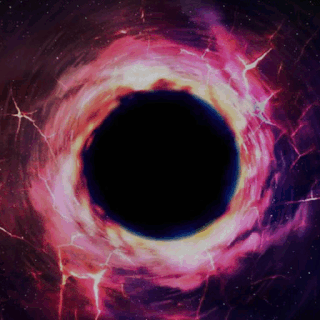

So what are we looking at? The visualization shows multiple views of the accretion disk, which is created by matter spiraling toward the black hole.
#BLACKHOLE GIF SOFTWARE#
The GIFs and videos were created by Jeremy Schnittman using custom software from NASA’s Goddard Space Flight Center and were released in conjunction with Black Hole Week. Across several different perspectives, the visualizations demonstrate how what we consider to be a dark space is actually one of the brightest places in the universe. 31 in a study submitted to the Astrophysical Journal.Off the heels of the first-ever photo of a black hole, NASA has just released incredible new visualizations that are a mesmerizing look at how a black hole’s gravity distorts our view.

The scientists detailed their findings online Jan. Rubin Observatory in Chile may "enormously help" discover more isolated stellar-mass black holes, Sahu said. This suggested this black hole may have received a kick from the supernova explosion that gave birth to it.įuture observatories such as Nancy Grace Roman Space Telescope and the Vera C. They also found this black hole is traveling at a speed of about 100,000 mph (162,000 kph). The researchers estimated this isolated black hole was about 7.1 times the mass of the sun. "It was immediately clear as daylight that it's a black hole, there was nothing else that could cause the deflections we measured." "It took two years of planning followed by six years of observing with Hubble, but it was very satisfying to see the incredible results," Sahu said. 10 wild things we learned about black holes in 2021īy combining Hubble observations with ground telescope data, the scientists discovered a 270-day-long microlensing event, called MOA-2011-BLG-191/OGLE-201, which they said likely came from an isolated black hole. "If the Hubble observations show large deflection but no light from the lens, then it would be a black hole." One way to distinguish an isolated black hole from a small-mass star is the fact that a black hole will deflect the light from background stars "enough that it can be measured with Hubble," Sahu said.

However, small-mass stars that move slowly in the sky may also look relatively dark and generate long-duration gravitational lensing events. "So we use these two as our main criteria - the event should have a long duration, and the lens should not be emitting any light." "Also, a black hole is expected to be dark," Sahu explained. Since a black hole is expected to be massive, its microlensing event is expected to have a long duration. The greater the mass of a gravitational lensing object, the longer the resulting brightening. A small number of them are expected to be caused by black holes." The survey programs typically detect about 2,000 microlensing events per year. "This microlensing phenomenon is caused by an intervening object, which can be a star or a white dwarf or a neutron star or a black hole or so on. Related: The strangest black holes in the universeĪ number of ground-based survey programs monitor millions of stars every night to detect gravitational lensing events "where a star slowly brightens and fades over days or months," Sahu said. "If one can detect and measure the bending of light caused by these massive objects, it's possible to detect them and measure their masses," Sahu said. As such, they can act like magnifying glasses, a phenomenon known as " gravitational lensing." The key behind this discovery is how powerful gravitational fields, such as those belonging to black holes, warp the fabric of space and time. And there must be lots of them out there." "And they have masses similar to the black holes found in binaries. "We now know that isolated black holes exist," Sahu said. Now, with the help of NASA's Hubble Space Telescope, scientists have discovered an isolated stellar-mass black hole about 5,150 light-years away from Earth, in the direction of the bulge in the center of the Milky Way. In contrast, isolated black holes lack such partners to help reveal their existence. Black holes are easier to detect in binary systems because their interactions with their partners can generate light or gravitational waves whose properties signal a black hole's presence. As their name suggests, black holes absorb any light that falls into them, making them difficult to detect against the dark of space. However, "nobody has ever been able to find an isolated black hole," Sahu said.


 0 kommentar(er)
0 kommentar(er)
